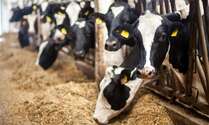Dairy Farms
Dairy by the numbers....
- Dairy Farms in South Dakota: 174
- Dairy cows: 127,325
- Pounds of milk produced in 2018: 2.4 billion pounds
- South Dakota national milk production rank: 20th
- Pounds of cheese produced each year: 265 million pounds
- South Dakota national cheese production rank: 8th
- Economic impact of dairy production: $647 million annually
- Economic impact of dairy processing: $1.77 billion annually
- The total economic impact of the dairy industry is: 2.4 billion annually
- One dairy cow generates $26,000 dollars of economic impact to the community each year
- Jobs created by dairy industry: 6,230
- Business taxes paid by dairy industry: $23,037,058
- Each year, South Dakota dairy cows consume on average:
- 927,360 tons of forage, corn or hay based
- 11,340,172 bushels of corn
- 74,250 tons of DDG
- 31,050 tons of SBM
Dairy Processing Plants in South Dakota:
- Valley Queen, Milbank
- Kasemeister Creamery, Frankfort
- Agropur, Lake Norden
- Bel Brands, Brookings
- SDSU Davis Dairy Plant, Brookings
- AMPI, Hoven
- AMPI, Freeman
- Dairiconcepts, Pollock
- Dimock Cheese, Dimock
- Dean Foods, Sioux Falls
Dairy facts
Most dairy barns use advanced ventilation systems to ensure healthy air quality. On warm days, farmers use fans and misters to keep cows cool and comfortable.
Dairy cows always have access to clean water while in the housing area. Additionally, many of today's dairy farms use "free-stall housing," a type of barn that allows cows to eat and sleep whenever and wherever they choose.
Dairy farmers provide a clean, dry, well-lit and well-ventilated separate calving area to ensure comfortable, safe and hygienic conditions for both mother and calf. After each birth, the farmer has the cow go through an appropriate resting period to ensure her health and comfort.
Dairy cows are not routinely treated with antibiotics. Just like humans, when illness happens cows are treated with antibiotics. While being treated with antibiotics, strict FDA guidelines are followed to withhold milk for sale. When a cow's milk is withheld, she is not put back into the milking herd until her milk tests free of antibiotics.
Every tanker load of milk is strictly tested for antibiotics. In the very rare event that any milk tests positive, it is disposed of immediately, never reaching the public. Farmers are financially liable if antibiotics are found in the milk.
Dairy farmers depend on healthy cows. By adopting sanitary milking practices and regular veterinary care, dairy farmers reduce the risk of disease and infections in the cow herd.
On farms, the people who milk the cows wear gloves to prevent any transfer of possible pathogens from cow to cow. A sanitizing solution is put on each cow's teats to reduce any bacteria that may exist on the teat, thus shrinking the possibility of transferring to the milk. The cow's udders are then washed, dried and the milking apparatus attached. After the cow has been milked and the equipment removed, the cow's teats are often treated again with a sanitizer. The equipment is then cleaned and sanitized.
Scientific studies on safety were used to develop the U.S. Department of Health and Human Services' Grade 'A' Pasteurized Milk Ordinance. All milk sold commercially for direct consumption or use in processing must adhere to the rules in the Ordinance.
Milk that is collected from dairy cows is cooled to 45 degrees Fahrenheit or less within two hours after the completion of milking. Milk produced by clean, healthy cows and under sanitary conditions contains a minimal number of bacteria immediately after milking. To reduce the possibility of any bacteria growth, the milk is quickly cooled. This practice assures that the most wholesome milk reaches the consumer.
It takes about two days for milk to go from the farm to the retail store. Keeping that milk safe and wholesome involves the people who collect the milk at the farms, as well as dairy farmers and milk processors. The milk is transported in insulated trucks which keep the milk cold and must meet sanitation standards. Bulk tankers are sealed to prevent tampering or contamination by an outside source.
When milk is received at the processor, it must again be checked to ensure it has been kept at or below 40o F during distribution and delivered within 48 hours after the cow is milked. The milk is pumped into large insulated vats at the processor. The milk is then pasteurized, homogenized, packaged and distributed to various retail stores, schools and households, all within about two days from the time of collection from the cow.
Both Organic and milk produced from non-organic farms contain the same combination of nutrients that make dairy products a healthy part of any diet.
The decision by milk companies to offer milk from cows not supplemented with rbST is a decision based on consumer requests and market demand and is not related to any health or safety issue.
Dairy products like milk, cheese, and yogurt are packed with nine essential nutrients which help to build and maintain strong bones, control blood pressure and maintain a healthy weight.
For more information about dairy please visit: www.midwestdairy.com

